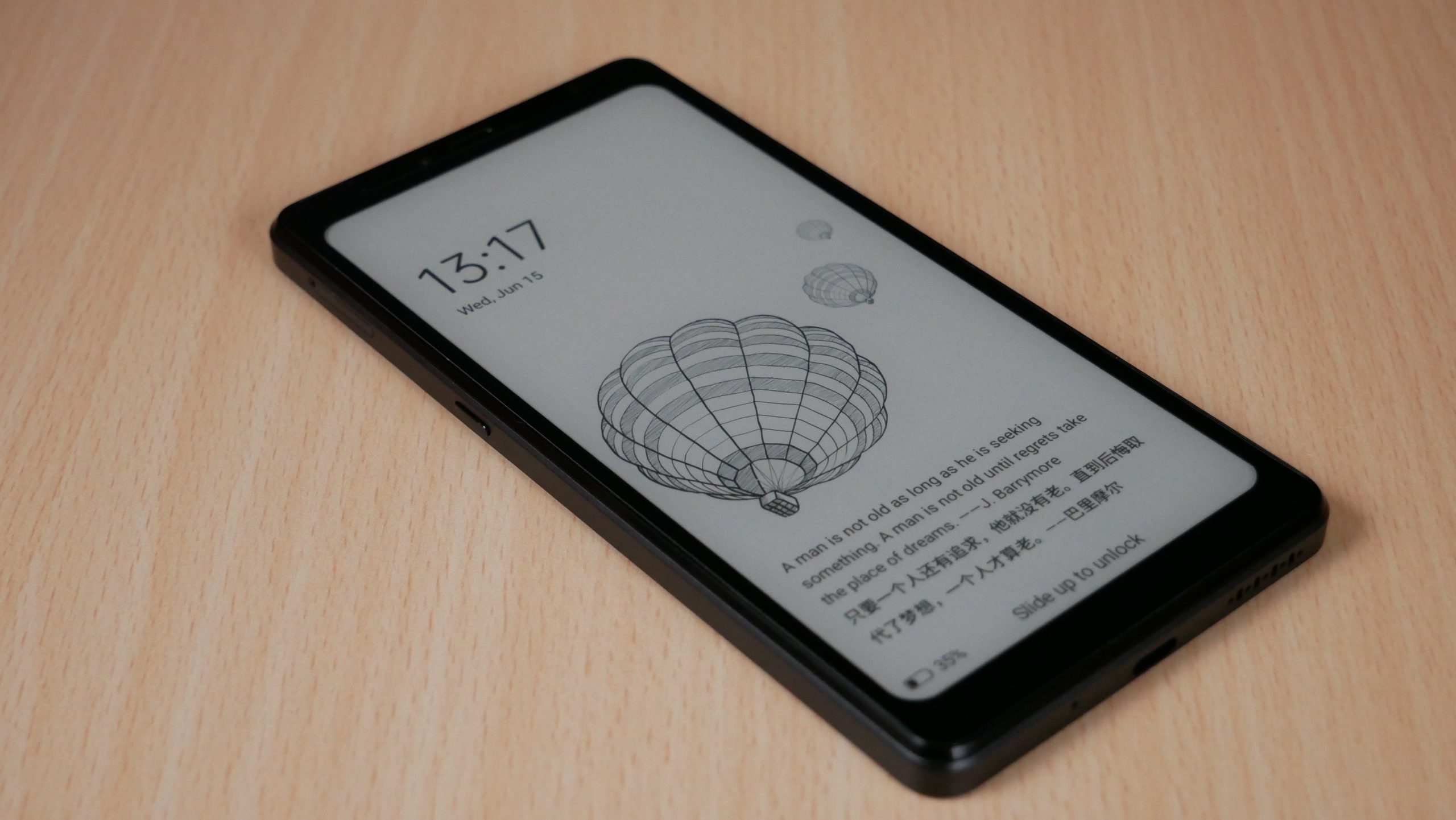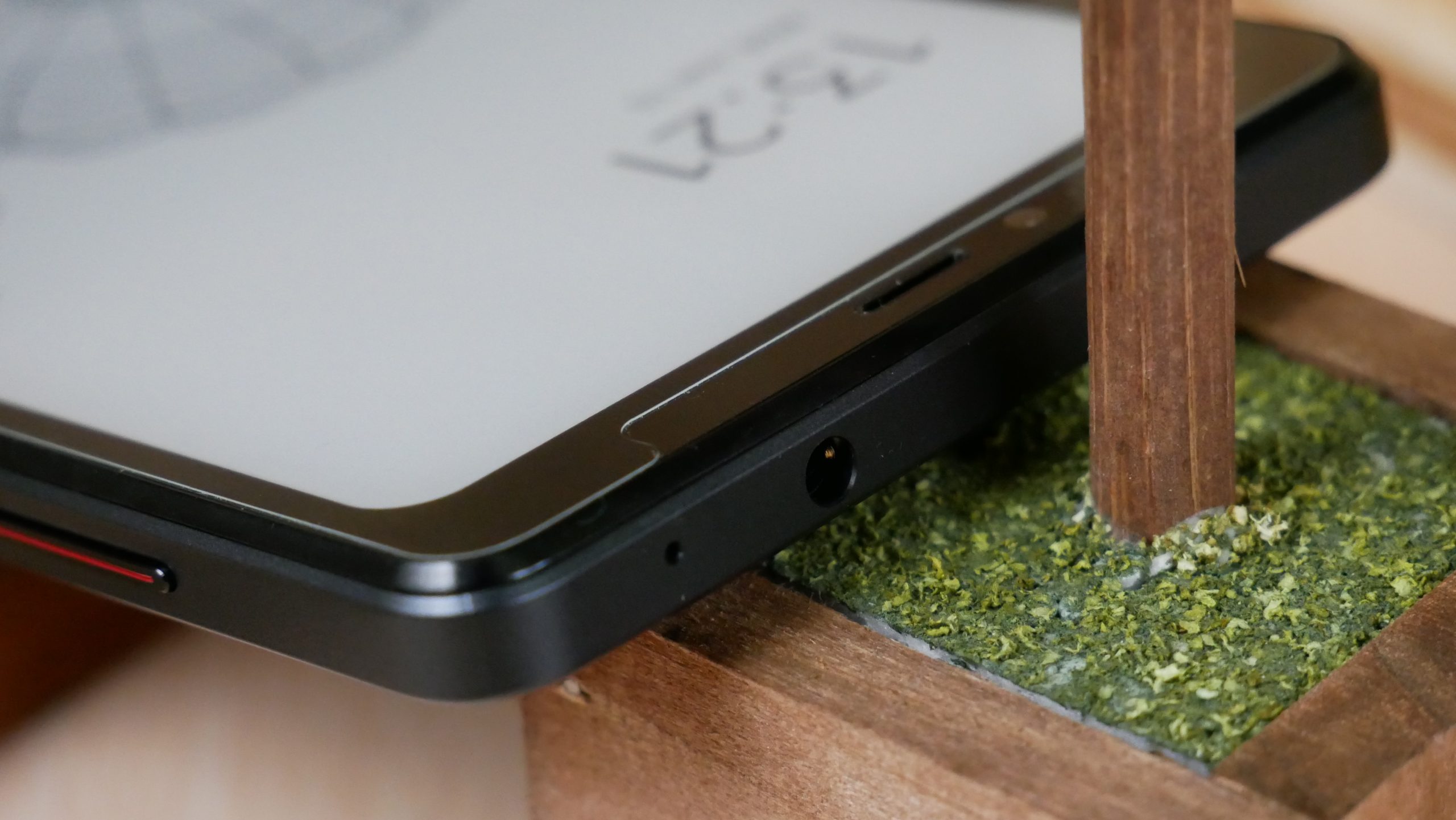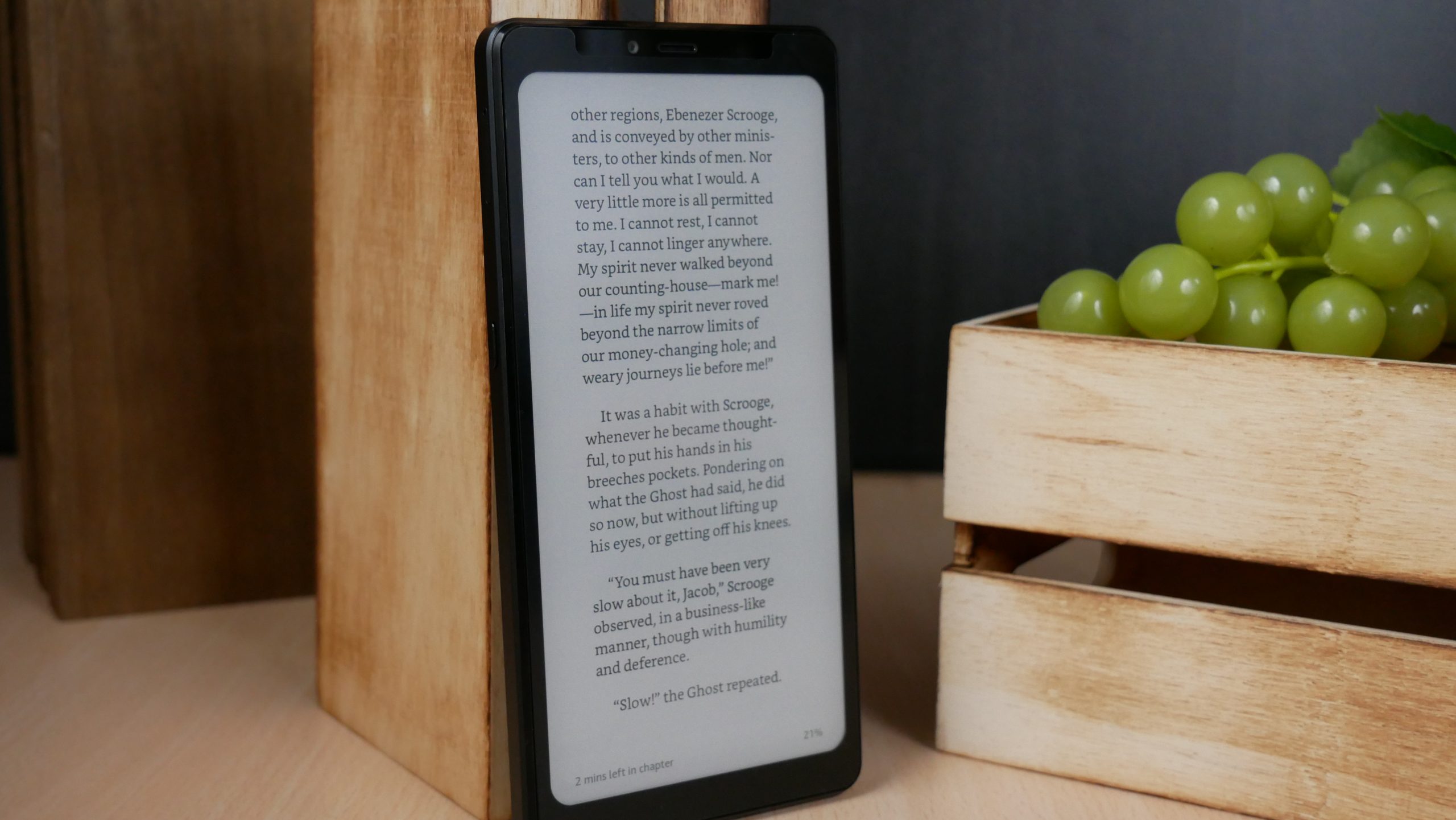Hisense is the only consistent brand in the world that releases pocket friendly E INK products. Just in the past couple of months they issued the Hisense Touch HIFI Music Player, Hisense HIFI Touch Lite, Hisense Touch HIFI Museum Edition and most recently the Hisense A9, which is a fully featured flagship Android 11 smartphone. The company tends to release 2 smartphones a year with eye-friendly E INK e-paper displays. I believe that the Hisense A9 might be the best one on the market and can easily be your primary phone.
Hardware
The Hisense A9 features an E INK Carta 1200 e-paper display. This is brand new e-paper technology that is only available in a handful of products such as Kobo Libra,2 and Kobo Sage. Additionally, the 11th Generation Kindle Paperwhite 5 and upcoming Pocketook Era have it too. The technology provides 20% faster response time and enables smoother handwriting and animations. It also support for E INK Regal technology for image updates. Regal virtually eliminates the need for a full refresh, giving the viewer smoother viewing transitions. The Carta 1200 modules consist of a TFT (thin film transistor), Ink layer and Protective Sheet. One of the benefits is that the touchscreen is incorporated into the module stack. It provides two-point multitouch and users can tap, gesture and utilize finger swipes . This tech is placed on top of the display module.
The A9 features a 6.1-inch E Ink display with a resolution of 824×1648 with 300 PPI. It has an impressive 84% screen-to-body ratio. The screen flush with the bezel and protected by a layer of glass. The color scheme of the phone is black and the backplate is also black, however it has glitter sand texture, which makes it a joy to touch and hold. There is a rear facing camera with a slight bump on the screen it is 13 MP and LED flash, it can record at 1920×1080. The front facing camera is 5MP and has a resolution of 2592×1944. It is rare that any E INK devices have cameras, and these ones are mighty impressive. There are volume rockers on the right side an E INK button on the left and power button on the top. You can read and use the A9 during the night, thanks to the front-lit display and color temperature system. There is a total of 27 white and amber LED lights.
Underneath the hood is a Snapdragon 662 octa-core 2.0 GHz with Adreno 610 GPU. If you are a big fan of high quality sound, the A9 is utilizing the ES9318 chip which allows for HiFi quality sound output while having integrated support for the LDAC, AAC, SBC, and APTX Bluetooth audio codecs. This makes the new A9 great for not only listening to audiobooks but some quality music, as well. For the best sound possible, you will want to plugin wired headphones via the 3.4mm headphone jack. There is also a small speaker on the bottom and also a microphone. There is a grill on the top so you can hear voice communication in HD. There are two different variants for RAM; 4GB or 6GB. I would go with the 6GB version because it is running Android 11 and since you will be using apps, the more RAM you have, the better they will perform. It has 128 GB of storage and has dual SIM card tray, one can be used for an SD Card that is capable of an additional 128GB. You can transfer apps, books and other content via the USB-C port, this is also how you charge it. It is powered by a 4,000 mAh battery. You can keep your phone secure with the face unlock, fingerprint sensor or a passcode. The dimensions are 159.00 x 79.50 x 7.80 mm and weighs 183 g.
Unlike the previous generation Hisense A7, this phone only supports 4G/LTE bands, instead of 5G. I think the reason this happened is because this phones primarily marketed in China and 5G towers aren’t widespread yet, and 5G data plans are horribly expensive. Whereas 4G plans are fairly cheap in China, you can get one for just $4 or $5 per month. Since the Hisense supports many different languages, including English, it is compatible with many of the leading telecom carriers in Canada, UK and United Kingdom. Here are the supported frequencies.
GSM, UMTS, LTE, TD-SCDMA
GSM frequencies: 850 900 1800 1900
Standard UMTS: 850 900 2100
Standard LTE LTE: 2100, 1800, 900, 850
TDD LTE: 2600, 2500, 2300, 1900
On a pure hardware level, mostly all of the Hisense 2022 models have tremendous build quality and it is really excellent to see a big brand like this, that doesn’t do e-paper devices on a lark, but they are really serious about refining the design and incorporating the latest generation hardware and software. It is not often that you can replace your flagship iPhone or Android phone with an e-paper one, but the A9 could be your next daily driver. The battery life is phenomenal, most other phones have to be recharged every day or every second day, but the A9 will last weeks. This is because the only time it needs any power is when the screen refreshes, so if you don’t use it for a couple of days, it will not waste any battery in standby mode. It supports a wide array of big name carriers such as Rogers, Telus and Bell in Canada and in the United States it will work with AT&T, T-Mobile and others. You can check out the major US telecom carrier bands HERE.
Software
The Hisense A9 is running Google Android 11, which is a very modern OS for e-paper phones. This OS provides a myriad of security features that are updated automatically by Google. Hisense also pushes their own updates, which introduces new features, addresses bugs and stability. This is a typical Android phone. You can do everything you normally would on any other phone, the big exception it that it is running E INK, so it has lots of optimization features devoted towards this type of display. For example you can take screenshots, not by pressing a combination of buttons, but simply dragging three fingers down form the top of the screen, to the bottom.
Let’s talk about what this phone does, that is very unique, that most other Android phones don’t have. It comes with 4 different refresh modes, that are similar to the Onyx Boox line of e-readers. The normal one is clear mode, which gives you nice looking app icons, text, and PDF image clarity, it also has balanced mode, which is similar to A2 mode, which degrades image quality, and provides a slight increase to performance. The two extra modes are the Smooth and Speed mode which makes playing videos, or light gaming a very real possibility.
Hisense has their own launcher that replaces the default vanilla Android experience. There is a default widget that shows the time and date, but you can install anything else you want via apps, such as a weather widget. In the top right corner is the WIFI symbol and time, the top left is where your notifications are. If you drag your finger down from the top center of the screen, downwards, there are a bunch of customization settings. You can turn auto rotate on/off, flashlight, WIFI network, data connection, ringer on/off, establish a hotspot, engage in power saver mode, take a screenshot, location and engage Bluetooth for wireless accessories, such headphones. This screen is also where you can adjust the front-lit display. This phone has white LED lights on the bottom of the screen and project light upwards, evenly illuminating the screen and not shining in your eyes. If you scroll your page to the left, you get a very unique Hisense experience. There is all sorts of RSS news publications you can subscribe to, gives you a breakdown of how many hours you have been using the phone on a daily, weekly or monthly basis. There is a bunch of micro-widgets that give other information.
One of the best things this phone does, is give you the option to automatically assign different speed modes to, on an app by app basis. For example, you might want to have YouTube or the internet browser on Speed Mode, so navigation and watching videos can be a thing. The e-reading app might want to be in clear mode, whenever it starts, so you can read at high resolution.
If you want to have greater control over the E INK experience, Hisense has you covered. There is an anti-aliasing option to make fonts razor sharp, and not blurry. There is a contrast mode to make the differences between black and white more pronounced. There are various battery saving modes, such as the standard power saving and Super power saving mode. You can get around two weeks of usage in super power saving mode, as it shuts down lots of background processes.
The only downside of this phone, is that it is not certified by Google, so you will not get Google Play and any app that requires Google Play Framework will not work properly. This sucks for major apps. The Hisense App Store has all sorts of apps available, but since this phone is primarily marketed in China, most of the apps are in Chinese. On the positive side the system language can be set to English and hundreds of other languages. If installing apps is important, you can download alternative app stores, or sideload in your own apps. I would recommend the Amazon App Store if your country supports it, it doesn’t work in Canada. The Samsung Galaxy Store is also a viable alternative, else you can check out the Good e-Reader App Store. I think it is important to download a app market, instead of sideloading apps. This is because frequently Android apps stop working when a new version comes out and it is hard to find a new version to sideload, whereas an app market will automatically keep them updated. It is possible to install the open source Gapps alternative to Google Play, we will be filming a future video on how to do this, but you can visit the site here. All you need to do to get started is select ARM64, and Android 10 and the Super package, which includes all Google apps. There is a detailed instruction guide for Hisense Phones HERE, but it is very technical.
Reading
The Hisense A9 has a screen that is comparable with most other smartphones on the market. One of the big reasons why it makes a good phone to use is the e-paper display. This is great because it is easy on the eyes and will not create eye strain. This is seriously very ideal for the crowd of people with vision disorders who get a headache when looking at a traditional LCD/LED phone for long reading sessions. The other phones are backlit, so the light shines into your eyes. E-paper does not have a backlit screen, when you are using the front-lit display, it projects light evenly across the screen.
This phone default reading app supports all of the major formats, such as EPUB, PDF, MOBI, TXT, DOC, CBR and CBZ. You can sideload in all of your favorite books, comics and manga. You do not need to pinch and zoom to read the frames, this is also ideal for webtoons. You can increase the font size, augment the font type, change the line spacing or margins. You can use the volume keys are page turn buttons, which is handy if you don’t always want to be swiping or gesturing with the touchscreen. You can use the phone one handed to read, which is a blessing.
You really aren’t going to get a great PDF experience if you sideload in your own, you want to read content optimized for mobile. Almost every major reading app out there is optimized for smartphones, so whether you borrow books from Overdrive Libby, read manga with hundreds of great apps or listen to Audible audiobooks. You will be able to utterly enjoy yourself.
I think it is important to remember, since there is no great app store preinstalled, you will have to source your own apps. Most people have a small pool of apps that use on a regular basis. On my iPhone 13 Pro Max, I just use Feedly, Thompson Reuters, Google News and Kindle to read books, Audible to listen to audiobooks and a bunch of social media apps. There might be 10 apps I use on a daily basis and most of them are reading ones, this type of workflow is ideal for an e-paper display, since I don’t really game on my phone, I use my iPad for that.
If you want a phone with an E INK screen to use Kindle, Nook or Kobo to read all of your favorite books, on a device that is always in your pocket the Hisense A9 should be what you are looking for. It does a better job than cheaper alternatives such as the Xiaomi InkPalm Mini 2 or the Xiaomi InkPad Plus, however the A9 costs double. I think it is worth it though, the Carta 1200 display really makes ebooks pop and it also has 300 PPI.
Wrap Up
Hisense releases two phones a year, one is a traditional black and white e-paper display and they tend to do the same model, but using the latest version of Kaleido. So far, nobody has released a Kaleido 3 e-paper product yet, mainly because the tech was released in the Spring and this doesn’t give manufactures a lot of time to make prototypes and ramp up mass production. I have a feeling if Hisense does release a color phone, it might not be for another couple of months. I think we will start seeing color e-readers and e-notes start coming out during the late summer or early fall, which would be Q3.
Should you buy the Hisense A9? If you have the A7, I would say it might be worth it to upgrade if you read all of the time, seriously, Carta 1200 is a game changer. It increases performance anywhere from 25% to 35% across the board, in conjunction with the various speed modes, you get a ton of performance benefits. I guess I would say, if you are an existing Hisense phone user, I would upgrade to this ASAP.
There are hundreds of millions of people in the western world that use Android or Apple phones on a daily basis, while e-paper ones are normally really fringe. You can’t walk into a phone store and see a Hisense model there, it is entirely sold and marketed online. This makes it difficult for the average person to really know of its existence and its impossible to see it in person. The best thing we can do, is give you a virtual experience by reading our comprehensive review, but also viewing our unboxing and review videos on YouTube, which are also embedded below.
(adsbygoogle = window.adsbygoogle || []).push({});
The post Hands on Review of the Hisense A9 4G E INK Android 11 Smartphone first appeared on Good e-Reader.







